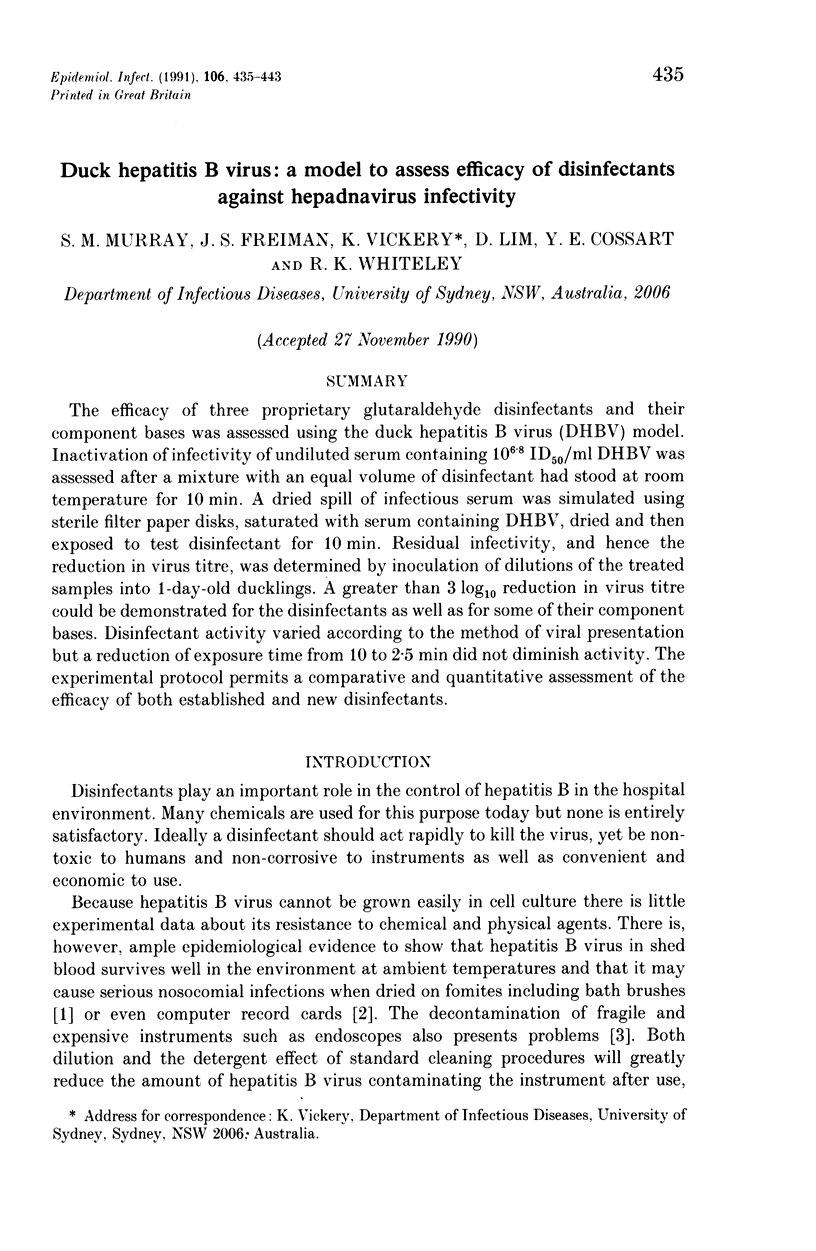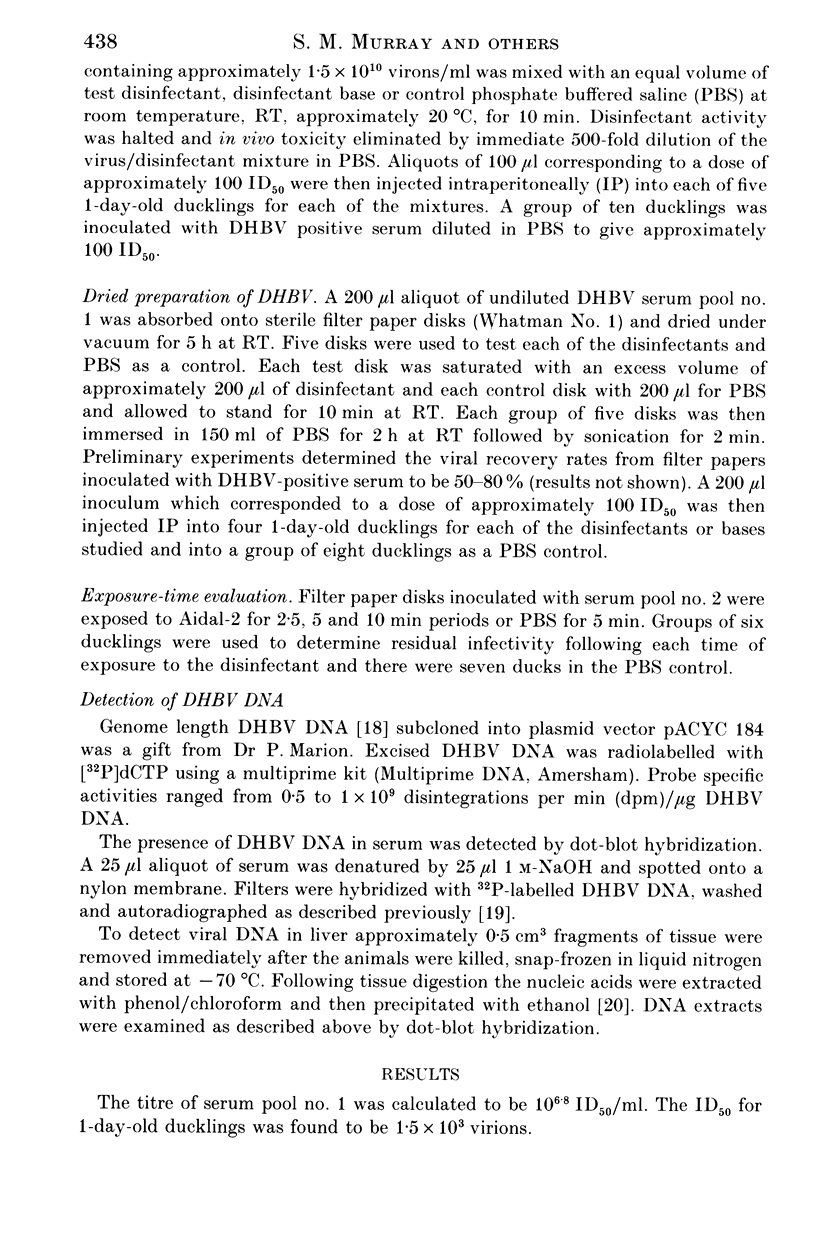Abstract
The efficacy of three proprietary glutaraldehyde disinfectants and their component bases was assessed using the duck hepatitis B virus (DHBV) model. Inactivation of infectivity of undiluted serum containing 10(6.8) ID50/ml DHBV was assessed after a mixture with an equal volume of disinfectant had stood at room temperature for 10 min. A dried spill of infectious serum was simulated using sterile filter paper disks, saturated with serum containing DHBV, dried and then exposed to test disinfectant for 10 min. Residual infectivity, and hence the reduction in virus titre, was determined by inoculation of dilutions of the treated samples into 1-day-old ducklings. A greater than 3 log10 reduction in virus titre could be demonstrated for the disinfectants as well as for some of their component bases. Disinfectant activity varied according to the method of viral presentation but a reduction of exposure time from 10 to 2.5 min did not diminish activity. The experimental protocol permits a comparative and quantitative assessment of the efficacy of both established and new disinfectants.
Full text
PDF








Selected References
These references are in PubMed. This may not be the complete list of references from this article.
- Bond W. W., Favero M. S., Petersen N. J., Ebert J. W. Inactivation of hepatitis B virus by intermediate-to-high-level disinfectant chemicals. J Clin Microbiol. 1983 Sep;18(3):535–538. doi: 10.1128/jcm.18.3.535-538.1983. [DOI] [PMC free article] [PubMed] [Google Scholar]
- Bond W. W., Moncada R. E. Viral hepatitis B infection risk in flexible fiberoptic endoscopy. Gastrointest Endosc. 1978 Aug;24(5):225–232. doi: 10.1016/s0016-5107(78)73517-0. [DOI] [PubMed] [Google Scholar]
- Braconier J. H., Nordenfelt E. Serum hepatitis at a home for the aged. Scand J Infect Dis. 1972;4(2):79–82. doi: 10.3109/inf.1972.4.issue-2.02. [DOI] [PubMed] [Google Scholar]
- Büscher M., Reiser W., Will H., Schaller H. Transcripts and the putative RNA pregenome of duck hepatitis B virus: implications for reverse transcription. Cell. 1985 Mar;40(3):717–724. doi: 10.1016/0092-8674(85)90220-x. [DOI] [PubMed] [Google Scholar]
- Cleaning and disinfection of equipment for gastrointestinal flexible endoscopy: interim recommendations of a Working Party of the British Society of Gastroenterology. Gut. 1988 Aug;29(8):1134–1151. doi: 10.1136/gut.29.8.1134. [DOI] [PMC free article] [PubMed] [Google Scholar]
- Freiman J. S., Cossart Y. E. Natural duck hepatitis B virus infection in Australia. Aust J Exp Biol Med Sci. 1986 Oct;64(Pt 5):477–484. doi: 10.1038/icb.1986.51. [DOI] [PubMed] [Google Scholar]
- Freiman J. S., Jilbert A. R., Dixon R. J., Holmes M., Gowans E. J., Burrell C. J., Wills E. J., Cossart Y. E. Experimental duck hepatitis B virus infection: pathology and evolution of hepatic and extrahepatic infection. Hepatology. 1988 May-Jun;8(3):507–513. doi: 10.1002/hep.1840080313. [DOI] [PubMed] [Google Scholar]
- Howard C. R., Dixon J., Young P., van Eerd P., Schellekens H. Chemical inactivation of hepatitis B virus: the effect of disinfectants on virus-associated DNA polymerase activity, morphology and infectivity. J Virol Methods. 1983 Sep;7(3):135–148. doi: 10.1016/0166-0934(83)90003-4. [DOI] [PubMed] [Google Scholar]
- Kobayashi H., Tsuzuki M., Koshimizu K., Toyama H., Yoshihara N., Shikata T., Abe K., Mizuno K., Otomo N., Oda T. Susceptibility of hepatitis B virus to disinfectants or heat. J Clin Microbiol. 1984 Aug;20(2):214–216. doi: 10.1128/jcm.20.2.214-216.1984. [DOI] [PMC free article] [PubMed] [Google Scholar]
- Marion P. L., Robinson W. S. Hepadna viruses: hepatitis B and related viruses. Curr Top Microbiol Immunol. 1983;105:99–121. doi: 10.1007/978-3-642-69159-1_2. [DOI] [PubMed] [Google Scholar]
- Marion P. L. Use of animal models to study hepatitis B virus. Prog Med Virol. 1988;35:43–75. [PubMed] [Google Scholar]
- Mason W. S., Aldrich C., Summers J., Taylor J. M. Asymmetric replication of duck hepatitis B virus DNA in liver cells: Free minus-strand DNA. Proc Natl Acad Sci U S A. 1982 Jul;79(13):3997–4001. doi: 10.1073/pnas.79.13.3997. [DOI] [PMC free article] [PubMed] [Google Scholar]
- McCutchan T. F., Simpson A. J., Mullins J. A., Sher A., Nash T. E., Lewis F., Richards C. Differentiation of schistosomes by species, strain, and sex by using cloned DNA markers. Proc Natl Acad Sci U S A. 1984 Feb;81(3):889–893. doi: 10.1073/pnas.81.3.889. [DOI] [PMC free article] [PubMed] [Google Scholar]
- Omata M., Uchiumi K., Ito Y., Yokosuka O., Mori J., Terao K., Wei-Fa Y., O'Connell A. P., London W. T., Okuda K. Duck hepatitis B virus and liver diseases. Gastroenterology. 1983 Aug;85(2):260–267. [PubMed] [Google Scholar]
- Pattison C. P., Boyer D. M., Maynard J. E., Kelly P. C. Epidemic hepatitis in a clinical laboratory. Possible association with computer card handling. JAMA. 1974 Nov 11;230(6):854–857. [PubMed] [Google Scholar]
- Summers J., Mason W. S. Replication of the genome of a hepatitis B--like virus by reverse transcription of an RNA intermediate. Cell. 1982 Jun;29(2):403–415. doi: 10.1016/0092-8674(82)90157-x. [DOI] [PubMed] [Google Scholar]


